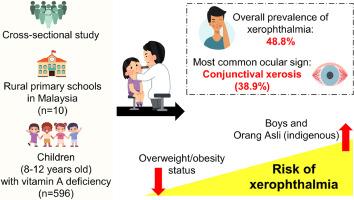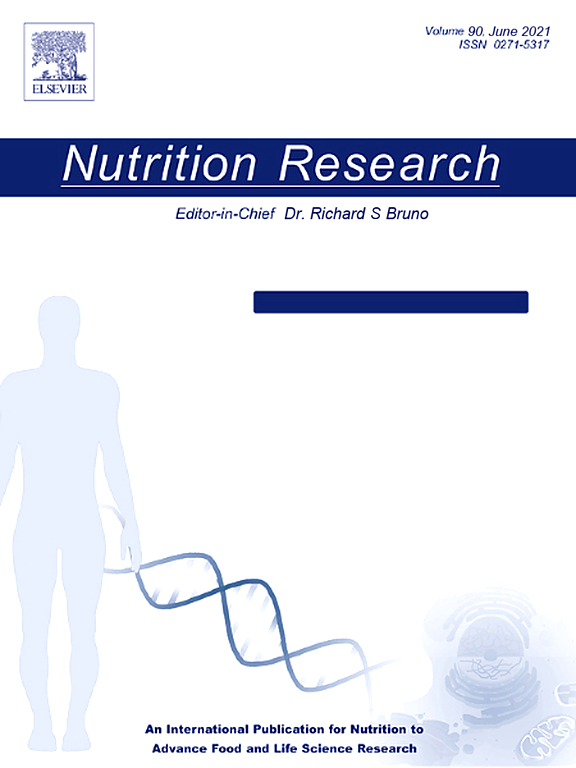High prevalence of xerophthalmia linked to socio-demographic and nutritional factors among vitamin A-deficient rural primary schoolchildren in Malaysia
IF 3.4
3区 医学
Q2 NUTRITION & DIETETICS
引用次数: 0
Abstract
Vitamin A deficiency (VAD) remains a major health issue in developing nations, contributing to preventable childhood blindness. However, there is lack of recent data on xerophthalmia, especially among school-aged children in Malaysia. We hypothesized that xerophthalmia persists among rural schoolchildren in Malaysia and potentially associated with socio-demographic status and malnutrition. We conducted a cross-sectional study on 596 schoolchildren (8-12 years) from ten rural primary schools located in five states across Malaysia. Children meeting the criteria for xerophthalmia assessment included those diagnosed with vitamin A deficiency (VAD) (plasma retinol < 0.70 µmol/L) and marginal VAD (plasma retinol 0.70 to < 1.05 µmol/L). The overall prevalence of xerophthalmia was 48.8%, with the most common ocular sign being conjunctival xerosis (38.9%). The occurrence of xerophthalmia was negatively associated with retinol-binding protein 4 (RPB4) (P=0.003), alpha-carotene (P=0.04), hemoglobin (P=0.004), weight (P=0.02), body mass index (BMI) (P=0.04) and WAZ (weight-for-age z-score) (P=0.04) status. Based on multivariate logistic regression analysis, a higher risk of xerophthalmia was observed in boys (Adjusted odd ratio [AOR]: 1.7, 95% confidence interval [CI]: 1.2-2.5) and Orang Asli (OA, indigenous) schoolchildren (AOR: 2.0, 95% CI: 1.3-3.0), while schoolchildren with overweight/obesity status (AOR: 0.5, 95% CI: 0.3-0.8) were associated with a reduced risk of xerophthalmia. The present study unveils a high prevalence of xerophthalmia among vitamin A-deficient primary schoolchildren in rural areas of Malaysia, especially among the indigenous community. The identified socio-demographic and nutritional factors associated to xerophthalmia would facilitate the implementation of more targeted interventions in addressing these issues.

在马来西亚缺乏维生素 A 的农村小学生中,干眼症的高发病率与社会人口和营养因素有关
维生素 A 缺乏症(VAD)仍然是发展中国家的一个主要健康问题,它导致了可预防的儿童失明。然而,目前缺乏有关干眼症的最新数据,尤其是马来西亚学龄儿童的干眼症数据。我们假设,在马来西亚的农村学龄儿童中一直存在着干眼症,而且可能与社会人口状况和营养不良有关。我们对马来西亚五个州十所农村小学的 596 名学龄儿童(8-12 岁)进行了横断面研究。符合眼干症评估标准的儿童包括那些被诊断为维生素A缺乏症(VAD)(血浆视黄醇< 0.70 µmol/L)和边缘性维生素A缺乏症(血浆视黄醇0.70至< 1.05 µmol/L)的儿童。眼干症的总发病率为 48.8%,最常见的眼部症状是结膜干涩(38.9%)。干眼症的发生与视黄醇结合蛋白 4 (RPB4) (=0.003)、α-胡萝卜素 (=0.04)、血红蛋白 (=0.004)、体重 (=0.02)、体重指数 (BMI) (=0.04) 和 WAZ(体重-年龄 Z 值) (=0.04) 状态呈负相关。根据多变量逻辑回归分析,观察到男孩患干眼症的风险较高(调整后奇数比 [AOR]:1.7,95% 置信区间 [CI]:1.2-2.5),而猩猩阿斯利人(=0.02)患干眼症的风险较低。而超重/肥胖(AOR:0.5,95% CI:0.3-0.8)的学龄儿童患眼干症的风险较低。本研究揭示了维生素A缺乏症在马来西亚农村地区小学生中的高发病率,尤其是在土著社区。所发现的与眼干症相关的社会人口和营养因素将有助于实施更有针对性的干预措施来解决这些问题。
本文章由计算机程序翻译,如有差异,请以英文原文为准。
求助全文
约1分钟内获得全文
求助全文
来源期刊

Nutrition Research
医学-营养学
CiteScore
7.60
自引率
2.20%
发文量
107
审稿时长
58 days
期刊介绍:
Nutrition Research publishes original research articles, communications, and reviews on basic and applied nutrition. The mission of Nutrition Research is to serve as the journal for global communication of nutrition and life sciences research on diet and health. The field of nutrition sciences includes, but is not limited to, the study of nutrients during growth, reproduction, aging, health, and disease.
Articles covering basic and applied research on all aspects of nutrition sciences are encouraged, including: nutritional biochemistry and metabolism; metabolomics, nutrient gene interactions; nutrient requirements for health; nutrition and disease; digestion and absorption; nutritional anthropology; epidemiology; the influence of socioeconomic and cultural factors on nutrition of the individual and the community; the impact of nutrient intake on disease response and behavior; the consequences of nutritional deficiency on growth and development, endocrine and nervous systems, and immunity; nutrition and gut microbiota; food intolerance and allergy; nutrient drug interactions; nutrition and aging; nutrition and cancer; obesity; diabetes; and intervention programs.
 求助内容:
求助内容: 应助结果提醒方式:
应助结果提醒方式:


